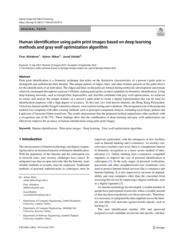Human identification using palm print images based on deep learning methods and gray wolf optimization algorithm
-
Yazar
Cevat Rahebi
-
Tür
Makale
- Yayın Yılı 2023
- Veritabanları Wos,Scopus
- DOI 10.1007/s11760-023-02787-6
-
Yayıncı
Signal, Image and Video Processing
- Dergi Signal, Image and Video Processing 18, ( 1 ), pp.961 - 973
- Tek Biçim Adres https://hdl.handle.net/20.500.14081/2094
-
Konu Başlıkları
Human identification
Palm print images
Deep learning
Gray wolf optimization algorithm
Abstract Palm print identification is a biometric technique that relies on the distinctive characteristics of a person’s palm print to distinguish and authenticate their identity. The unique pattern of ridges, lines, and other features present on the palm allows for the identification of an individual. The ridges and lines on the palm are formed during embryonic development and remain relatively unchanged throughout a person’s lifetime, making palm prints an ideal candidate for biometric identification. Using deep learning networks, such as GoogLeNet, SqueezeNet, and AlexNet combined with gray wolf optimization, we achieved to extract and analyze the unique features of a person’s palm print to create a digital representation that can be used for identification purposes with a high degree of accuracy. To this end, two well-known datasets, the Hong Kong Polytechnic University dataset and the Tongji Contactless dataset, were used for testing and evaluation. The recognition rate of the proposed method was compared with other existing methods such as principal component analysis, including local binary pattern and Laplacian of Gaussian-Gabor transform. The results demonstrate that the proposed method outperforms other methods with a recognition rate of 96.72%. These findings show that the combination of deep learning and gray wolf optimization can effectively improve the accuracy of human identification using palm print images.
-
Koleksiyonlar
Fakülteler
Mühendislik Fakültesi




